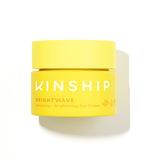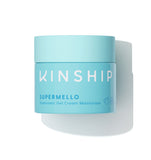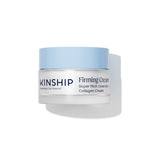Eye creams target puffiness, dark circles, and fine lines, leaving the skin around your eyes looking refreshed and radiant. Incorporating an eye cream into your skincare routine is an excellent way to maintain a youthful and healthy appearance.
If you're wondering how to apply eye cream correctly, you're not alone. Many people ask, "Can I put eye cream on my eyelids?", "How much eye cream to use?" or even, "Can I apply eye cream before moisturizer?"
Generally, as a rule of thumb, you should apply products based on thickness or texture — meaning lighter layers go first and heavier ones on top. So, if your eye cream is richer and heavier than your moisturizer, it should go on after. For best results, use a delicate touch and lightly pat the product into your skin without tugging at the delicate eye area.
But there is more to that!
Today, we will discuss certain considerations that can help you decide whether to apply eye cream before or after your moisturizer.
Understanding how to apply eye cream and whether to use it before or after moisturizer is key to seeing noticeable results over time.
What is Eye Cream?
Eye cream is a skincare product tailored to the sensitive skin around your eyes. This area is very sensitive and thinner than the rest of your face, leading to concerns such as dry skin, puffiness, and dark circles.
These products are formulated with special ingredients to effectively address specific eye concerns while being gentle. They can also help combat collagen loss, a common cause of skin aging.
Eye creams offer a range of benefits to help keep your delicate eye area looking its best:
- Diminishing Puffiness: If you wake up with puffy eyes, eye creams can help. Many contain active ingredients like caffeine, which can constrict blood vessels and reduce swelling, making you look refreshed.
- Minimizing Dark Circles: Dark circles can make you look tired even when you are not. Eye creams with lightening ingredients like vitamin C and niacinamide can help lighten these shadows and give you a more awake appearance.
- Hydrating the Eye Area: The skin around your eyes is prone to dryness. As such, eye creams often include moisturizing ingredients like hyaluronic acid and glycerin to keep this area hydrated and smooth. Adding this to your daytime routine and care routine may help reduce the visible signs of early anti-aging and improve your overall looking skin.
A good eye cream should contain active ingredients that address different concerns. Below are some key ones.
- Caffeine: Helps reduce puffiness by constricting blood vessels.
- Hyaluronic Acid: Provides deep hydration to plump and smooth the skin.
- Vitamin C: Brightens the skin and diminishes dark circles.
- Peptides: Boost collagen production to firm and tighten the skin.
- Niacinamide: Reduces inflammation and helps lighten dark circles.
- Antioxidants: Protect the skin from environmental damage.
Kinship's Brightwave Eye Cream features red algae (which helps reduce the appearance of dark circles) and chaga mushroom (known for its soothing and anti-inflammatory properties).
This product is also formulated with Vitamin C Ester, a gentle yet effective form of vitamin C that brightens the eye area without irritating it.

What is Moisturizer?
Moisturizer is a skincare product that keeps skin hydrated, smooth, and soft. It creates a protective barrier to lock in moisture to prevent skin from drying out. This is particularly important after cleansing, as cleansing can strip away natural oils.
Types of Moisturizers
There are several types of moisturizers, each suited for different skin types and needs.
- Creams: These products have a thicker and richer consistency, making them ideal for dry or mature skin. They create a more substantial barrier to retain moisture and are most effective when used as part of a nighttime routine.
- Lotions: Lotions are a more lightweight alternative to creams and are well-suited for individuals with normal to slightly dry or slightly oily skin types. Due to their fast absorption, they can be applied during the day or at night, providing flexibility in skincare routines.
- Gels: With a lightweight, non-greasy texture, gels are ideal for oily or acne-prone skin. They hydrate without clogging pores and feel refreshing on the skin.
Some moisturizers are a combination — such as our Supermello Hyaluronic Gel Cream Moisturizer, making it a lightweight product that deeply moisturizes and strengthens the skin barrier.

Ingredients for a Good Moisturizer
A good moisturizer typically contains ingredients that hydrate, protect, and nourish the skin, such as the ones listed below.
- Humectants (like hyaluronic acid and glycerin) attract water to the skin, keeping it hydrated.
- Emollients (like ceramides and plant oils) smooth and soften the skin.
- Occlusives (like petrolatum and dimethicone) create a barrier to trap moisture.
- Antioxidants and Vitamins (like vitamins E and C and green tea extract) protect the skin from environmental damage.
How much moisturizer you should use varies, but a pea-sized amount for the face is generally enough. Too much can leave your skin feeling greasy, while too little might not be effective.
Recommended Products
The Skincare Routine Order

Many may wonder, "Should eye cream be applied before or after moisturizer?" When it comes to your skincare routine, knowing what step is eye cream or moisturizer is essential.
The skincare routine order can be confusing, but we will give you the basic step-by-step.
The main tip is to apply skincare products from thinnest to thickest consistency. Below is a quick breakdown.
- Step 1. Cleanser: A gentle cleanser removes all the makeup, dead skin cells, oil, and other pollutants from the skin. Our Naked Apple Niacinamide Pore Gel Cleanser reduces blemishes without being harsh on your skin.
- Step 2. Treatment (optional): Spot treatments are concentrated products that help directly address skin concerns—usually pimples. Our Pimple Potion clears the skin and prevents acne pimples from popping up. It is also benzoyl peroxide-free, making it great for sensitive skin.
- Step 3. Serums: Serums like our Brightwave Face Serum target specific concerns, such as wrinkles, acne, dryness, and dull skin.
- Step 5. Eye Cream: The right eye cream, such as our Brightwave Eye Cream, helps your skin retain moisture, lessening visible fine lines and wrinkles.
- Step 6. Moisturizer: Moisturizers like Supermello reduce fine lines, smooth and hydrate skin, prevent dryness, and soothe sensitive skin.
- Step 7. Sunscreen (Daytime only): Sunscreen shields your skin from the harmful effects of UV rays. Our Self Reflect Probiotic Moisturizing Sunscreen is a mineral that has moisturizing benefits and will not cause you to break out.
Aside from having a good skincare routine, remember to allot time between products to give your skin time to absorb them.
The skin around your eyes is delicate and sensitive, so proper eye cream application is essential for effectiveness. If you apply too much or use the wrong technique, you might not get the results you're hoping for.

Eye Cream Before Moisturizer
Most people think applying eye cream before a moisturizer is a good idea because it allows for better absorption.
After all, you will be applying eye cream on a fresh and clean patch of skin with nothing in the way of it seeping around the eye area. This allows the beneficial ingredients to quickly absorb where they are needed most.
One thing to remember when applying eye cream first is that these products are often lighter than moisturizers, so there is a chance your moisturizer might slightly move or dilute the eye cream when applied.
A solution to this is to wait the right amount of time after putting on eye cream to give your skin enough time to absorb it before applying moisturizer.
Eye Cream After Moisturizer
Meanwhile, some people prefer applying eye cream after moisturizer. This is usually the case if your eye cream is heavier and richer than the moisturizer.
If you try applying a thicker moisturizer before eye cream, you will also have to wait for your skin to absorb the moisturizer.
On top of that, apply only a thin layer of moisturizer so it will not be too much of a roadblock to the eye cream. This will also reduce your waiting time.
Customizing Your Routine

As you tailor your outfits to fit your unique fashion style, your skincare routine can also be personalized to meet your needs.
In this section, we will discuss certain considerations when customizing your skincare routine according to your skin type and skincare products.
Sensitive Skin
For sensitive skin, it is best to apply eye cream first since it can act as a shield against possibly harsher products in your skincare routine — such as serums with retinoids or exfoliating acids.
Applying eye cream before everything else allows it to effectively target sensitive areas without interference. This way, you can ensure that the eye cream can work its magic without being diluted or blocked by other products.
Oily and Dry Skin
For those with oily skin, using a lightweight eye cream and a mattifying moisturizer is best to help control excess oil and shine.
If you have dry skin, choosing a richer eye cream and a hydrating moisturizer like our Supermello Hyaluronic Gel Cream Moisturizer is recommended to provide extra nourishment and moisture to the delicate skin around the eyes.
This tailored approach will help maintain the health and hydration of your skin in the eye area.
Targeted Treatments
To address puffy eyes, consider applying a cooling eye gel before your moisturizer to help reduce puffiness quickly.
If you have dark circles, you may want to try using a brightening eye cream like our Brightwave Eye Cream after applying a lightweight moisturizer. This can create a smooth canvas for the eye cream to work its wonders effectively.
Consistency is Key
When applying skincare products, it's important to consider the viscosity of your eye cream and regular moisturizer. This ensures that your skin acquires the maximum eye cream and moisturizer benefits.
If your eye cream has a lighter and thinner texture than your moisturizer, it should be applied first.
On the other hand, if the eye cream is thicker and richer, it should be the final layer to seal all the beneficial properties of the products effectively.
Absorption Rates
When selecting skincare products, it is helpful to consider those with a lighter texture as quick-absorbing, while thicker products take more time to absorb.
To prevent a sticky or messy application, allow the thinner products to fully sink in before applying the thicker products. This sequential approach ensures that each product can perform effectively without interfering with the absorption of the next.
If you are unsure, you can first test the absorption rates of your products to figure out their correct order in your skincare routine.
For an added layer of sun protection, always apply sunscreen after your eye cream. Choose between a physical sunscreen and chemical sunscreen, depending on your preference. Don’t forget to wear sunglasses during the day to protect your eyes and skin from harmful UV rays.
Other Eye Cream Mistakes to Avoid
Are you making the most out of your eye cream? While you may have the best intentions, a few common slip-ups could sabotage your efforts.
Below, we will break down some common eye cream mistakes that can prevent you from experiencing all its benefits.
Applying Eye Cream on Dry Skin
Applying eye cream on damp skin helps it absorb better.
One good tip is to gently pat your face dry after cleansing to leave a hint of moisture on your skin. This damp canvas helps the eye cream absorb better, effectively working magic!
Using Too Much Eye Cream
We understand that putting more of a product on can sometimes feel better. However, using too much of anything can lead to product waste and potential irritation.
Aim for just a pea-sized amount of eye cream for both eyes. Using too much of the product can lead to milia (tiny white bumps) or irritation, but too little will make it ineffective.
Applying Eye Cream Too Close to the Eyes
Eye cream is fantastic for the delicate under-eye area, but it is best to keep it away from the skin too near beside your eyeballs. The skin there is super sensitive, and cream can cause irritation or puffiness.
Instead, apply the eye cream to the orbital bone area, the bony ridge around your eye socket. Gently pat it in, staying away from the lash line.
Rubbing Instead of Patting
The under-eye area is thin and delicate, so knowing how to apply eye cream properly is important.
Rubbing it can tug and stretch the skin, causing wrinkles. To avoid this, use your ring finger. It is naturally weaker than your other fingers, making it perfect for gentle patting.
Pat the eye cream into your skin until it is completely absorbed.
Skipping Eye Cream in the Morning
Night eye cream is great to help your eyes recover as you sleep. However, nighttime is not the only time your eyes need attention!
Adding eye cream to your morning routine can also help protect your skin against environmental aggressors like pollution and UV rays.
On top of that, eye cream can also help reduce morning puffiness, making you look more refreshed and awake.
Ignoring Your Eye Area's Specific Needs
Like the rest of your face, your eye area might have specific skin concerns. Do you struggle with dark circles, puffy eyes, or fine lines? Different eye creams target different issues.
Look for a brightening formula for dark circles, a hydrating cream for dryness, or a formula with retinol to target fine lines. Choosing the right eye cream for your needs is key to achieving radiant results!
Frequently Asked Questions (FAQs)
Do you have more questions about eye cream and moisturizer? Read through our FAQ section below.
Should You Use Eye Cream in the Morning or at Night?
You should use eye cream ideally both in the morning and at night.
A morning eye cream can give you a brighter, more awake appearance, revive your complexion, and address temporary puffiness.
Meanwhile, a night eye cream gives your skin much-needed hydration while you sleep.
How Often Should You Use Eye Cream?
Using an eye cream in the morning and night can combat this and keep your eyes looking bright and youthful.
The delicate skin around your eyes shows signs of aging, like fine lines and puffiness, earlier than the rest of your face. A consistent skincare routine with eye cream will improve your skin's appearance while preventing future damage.
Can You Just Use Moisturizer as Eye Cream?
You can technically use a moisturizer around your eyes, but it might not be ideal. The skin there is much lighter and more delicate than the rest of your face, so that regular moisturizers might irritate people with sensitive skin.
Eye creams are specially formulated to be gentle and address specific skin concerns, like puffiness or dark circles.
Key Takeaways on Eye Cream Before or After Moisturizer?
So, should you apply eye cream before or after moisturizer?
People tend to apply eye cream before moisturizer so the product's ingredients can immediately target the delicate skin and protect it against harsher products.
However, this is not a one-size-fits-all answer since the correct order in your skincare routine should depend on your skin concerns and products.
For instance, if your eye cream is thicker than your moisturizer, then you should apply moisturizer first. Or, if you have sensitive skin, you might want to apply eye cream before everything else.
If you want to start a skincare routine but do not know where to start, our products here at Kinship can help you begin your journey.
Kinship's Brightwave Eye Cream is an excellent option, featuring red algae (which helps reduce the appearance of dark circles) and chaga mushroom (known for its soothing and anti-inflammatory properties). Regular use of such nutrient-dense treatments can lead to best results.
This product is also formulated with Vitamin C Ester, a gentle yet effective form of vitamin C that brightens the inner corner and outer corner of your eyes without irritation.
Recommended Products



